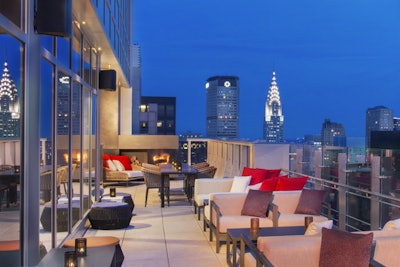
Bar 54 opened in New York in February with a superlative distinction: Located on the 54th floor of the newly constructed Hyatt Times Square, it's the highest rooftop bar in the city. Span Architecture designed the space, which has views of the Chrysler Building, One World Trade Center, and both the East and Hudson Rivers. Julie Reiner of Mixtress Consulting created the beverage program. The 122-seat lounge has both indoor and outdoor space available for events and has outdoor fireplaces at both ends of the terrace.
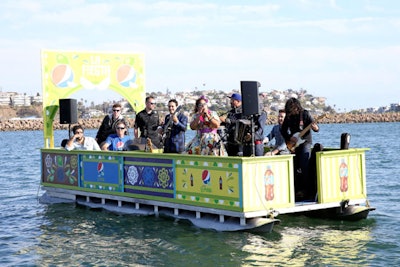
On May 20, Pepsi launched its new "Limon"-flavored soft drink with a festive event at Chace Park in Marina Del Rey, California. The promotion featured a concert from La Santa Cecilia, and the band performed on a colorful, decorated boat.
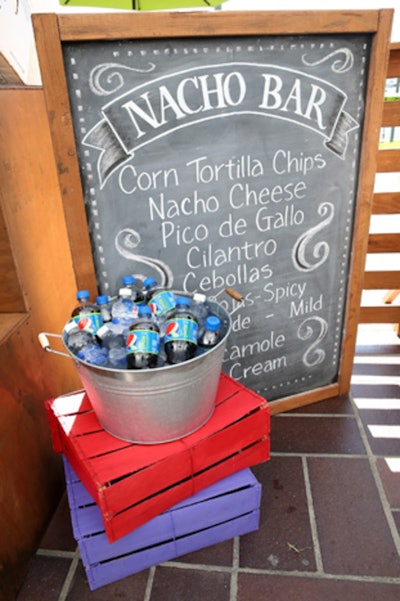
Casual snacks accompanied the free-flowing Pepsi. At a nacho bar, guests could top corn tortilla chips with pico de gallo and cilantro.
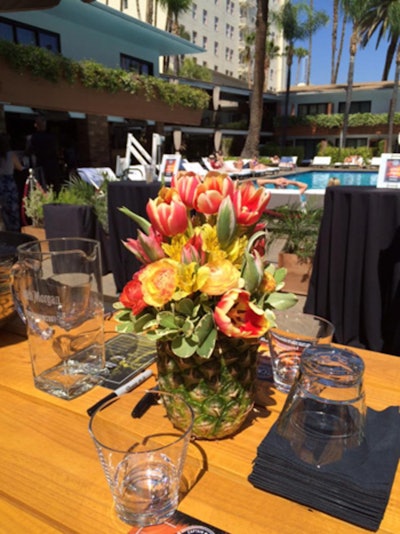
On May 22, Captain Morgan launched new rum flavors—including grapefruit, coconut, and pineapple—with an event at the Hollywood Roosevelt Hotel in Los Angeles. To underscore the beverages' fruity flavors, flower arrangements from Athletic Club Flower Shop were contained in hollowed-out pineapples.
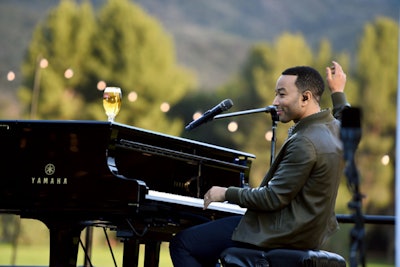
On May 18, beer brand Stella Artois launched its new "Host Beautifully" campaign with an event at the Golden Oak Ranch in Los Angeles. The open-air event featured a performance from singer John Legend. Mother New York handled production.
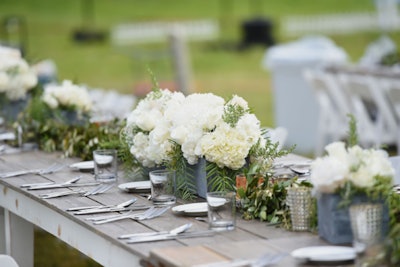
For dinner, guests sat at long, farm-style tables decked with clean white floral arrangements and no linens.
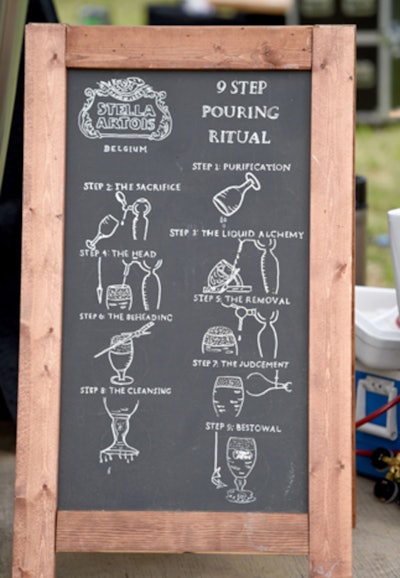
The event's promotional signage was printed onto rustic chalkboards.
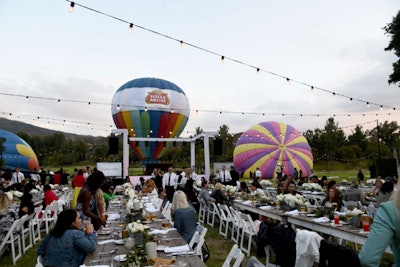
Guests could float above the crowd in tethered hot-air balloons branded with the Stella Artois logo.
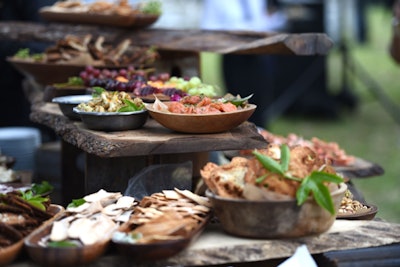
Menu items were served in rustic vessels arranged on slabs of wood. Heirloom LA handled catering, and the menu was designed by chef Aliya Leekong.
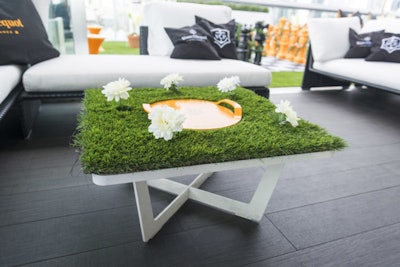
Champagne label Veuve Clicquot hosted a promotion called "Yelloweek" in Toronto May 5 to 11. A kickoff party for the series of events was held at Thompson Rooftop Lounge on May 1. Bubbly was served on tray tables covered in grass and daisies. Melissa Andre Events handled production.

Hanging replicas of hot-air balloons also played into the whimsical decor.
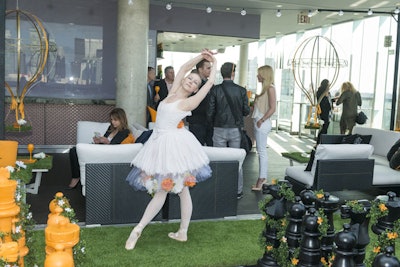
Dressed in the brand's signature yellow-and-white hues, a ballerina entertained guests with impromptu performances on the rooftop.
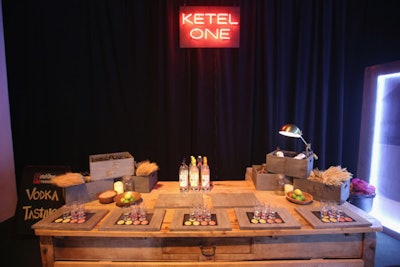
On May 13, a promotional event for Ketel One vodka took place at New York's Sir 37. To let guests experience the brand's classic and flavored varieties, a tasting bar was stocked with sample pours. Ketel One's national mixologist, Ricky Gomez, led attendees through the taste test.
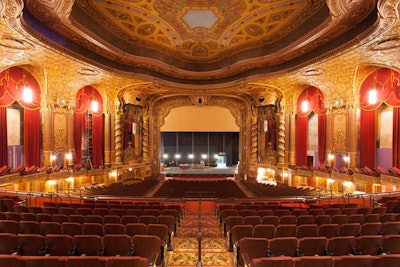
Following a years-long restoration, the historic Kings Theatre in Brooklyn's Flatbush neighborhood opened in February with a grand-opening concert featuring Diana Ross. Formerly called the Loew's Kings Theatre, the venue originally opened in 1929 but has been closed for the past 40 years. Now owned by the city, the space finished a $94 million renovation that restored its ornate design and modernize the facility for live performances. At 3,250 seats, it is now the largest theater in Brooklyn.
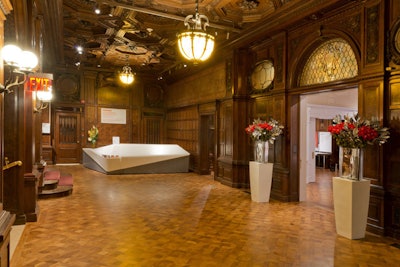
After a three-year renovation, Cooper Hewitt, Smithsonian Design Museum reopened in December. The Upper East Side mansion, formerly the home of Andrew Carnegie, retains many of its original architectural details such as the wood paneling and grand staircase in the Great Hall, which seats 70 or holds 250 for receptions, but now boasts 60 percent more exhibition space and systems upgrades that modernized the building. The museum also offers event space in its large and lush Arthur Ross Terrace and Garden, a ground-floor lecture room, and the intimate Trustees Room located adjacent to the mansion.

The restored Knickerbocker Hotel reopened to guests on February 12. Originally opened in 1906 by John Jacob Astor IV, the Beaux-Arts building has spent decades as office space but now returns to its original life as a luxury property. The Times Square hotel claims a colorful history, including the creation of the martini in 1911 by its bartender, Martini de Arma de Taggia as a drink for John D. Rockefeller. The 330-room property has dedicated meeting space. Its largest room, the Salon, is 2,200 square feet and seats 100 or holds 200 guests for receptions. Audiovisual equipment and free Wi-Fi are available for the fourth-floor space. The hotel also is home to the highly anticipated 120-seat restaurant, Charlie Palmer at the Knick, and a pre-event foyer is adjacent to the bar.
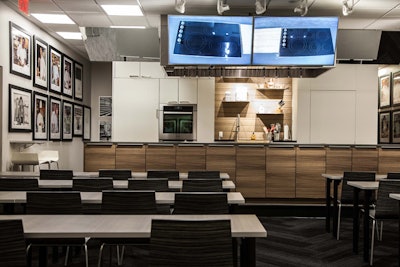
The redesigned De Gustibus Cooking School by Miele, located on the eighth floor of Macy’s Herald Square, opened in December. The school, celebrating its 35th anniversary, offers classes for as many as 60 people as well as hosts corporate groups. Warren Red designed the interiors, which combine a professional kitchen, stage, and classroom as well as appliances from Miele.

Ink48, a Kimpton hotel, finished a renovation of its "Heaven Over Hell" penthouse suite in November. The bilevel space—which has views of the city skyline and Hudson River—features a living room and bedroom with floor-to-ceiling windows, two bathrooms, and a 2,200-square-foot wraparound terrace. Located in Hell's Kitchen near the Jacob K. Javits Convention Center, the space has been used as an off-site showroom and for post-trade show receptions, as well as for weddings and other social events. The hotel's Print restaurant provides catering. The space holds 60 for receptions.
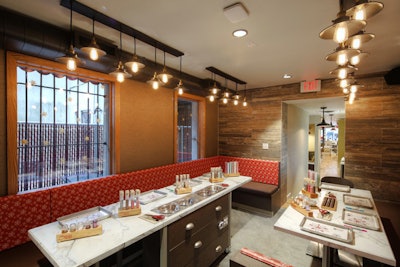
Available for private events or a sweet teambuilding option, Voilà Chocolat opened in December. The Upper West Side venue offers chocolate-making classes as well as event space under the direction of owner Peter Moustakerski along with former Jacques Torres chocolatier Christophe Toury and chocolate scientist Dennis Teets. For chocolate-making events, the front area seats 25 at individual workstations. A reception space in the back seats 15. For receptions, the entire 1,400-square-foot venue holds 75.
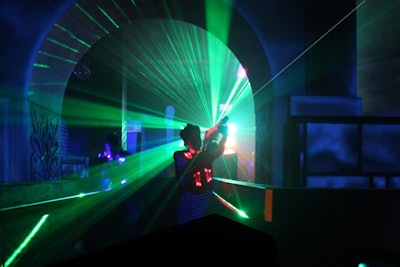
The bowling and entertainment venue Bowlmor Lanes added a 3,000-square-foot laser-tag arena and a ropes course to its Chelsea Piers location in December. The laser-tag arena holds as many as 30 people at a time and can be adjusted for varying levels of difficulty. The ropes course holds 15 people and includes challenges such as narrow planks and tightropes. The new activities are available as part of teambuliding or other corporate events.
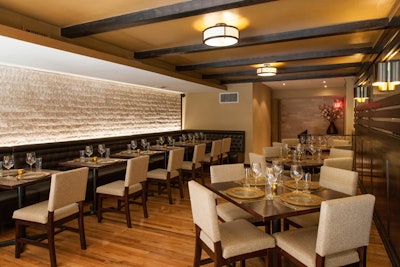
Located on the Upper West Side, Indian restaurant Awadh features the cuisine and techniques of its namesake region of India. Known for its kebabs, the restaurant also has a tea program with estate-grown teas from India and a global wine list. The first floor of the contemporary space includes a bar and lounge-style seating. The second-floor dining room, which is available for private events, seats 50. The restaurant opened in June.
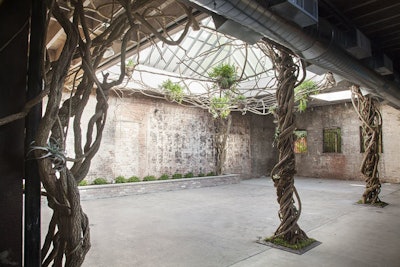
Located near the southern end of the High Line park, Gansevoort Market is a former trading post that now contains a number of food and beverage purveyors. The 8,000-square-foot marketplace retains historic detail such as its brick walls that date to the mid-1800s and is fronted by four garage-style doors that stay open in warmer weather. A 60-seat area, topped by a skylight, can be used for private events and is bordered by a twisted vine structure created by Charlie Baker of Baker Structures. The entire venue holds about 400 people for receptions, and amenities include a full PA system and other audiovisual capabilities. The marketplace opened in October.
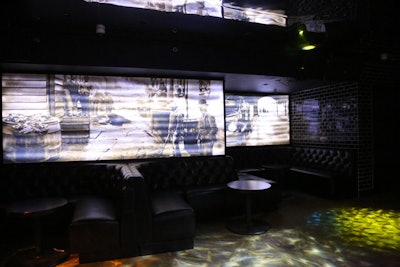
The Prohibition-theme speakeasy Bandit's Roost opened in TriBeCa in November. Located underneath Church Street Tavern, the hideaway is named from a 19th-century Jacob Riis photo of a New York alleyway filled with gangsters. The space features more photos by Riis, black subway tile walls, and black leather banquettes. Guests enter using a keypad, and planners can set up customized door codes for events. The venue has a DJ booth and holds 75 people at 10 tables and standing room.
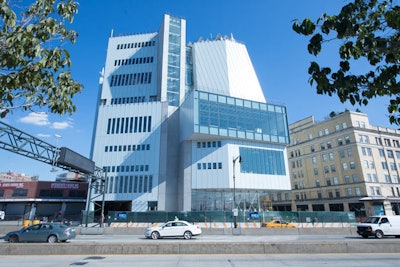
The Whitney Museum of American Art officially debuts its new downtown location May 1, trading the Upper East Side for the meatpacking district. The 220,000-square-foot contemporary art museum is designed by architect Renzo Piano and will include a 170-seat theater, a black box theater with an adjacent outdoor gallery, and double the exhibition space of its previous home. The museum is seeking LEED Gold certification and incorporated a number of sustainable features such as a cogeneration plant to help the museum reduce its energy cost by 22.2 percent. A green roof, plaza-level planters, and a storm water detention tank reduce storm water runoff, and the museum’s housekeeping plan limits the use of harmful chemicals in the building. During construction, one-fifth of the construction materials were recycled.
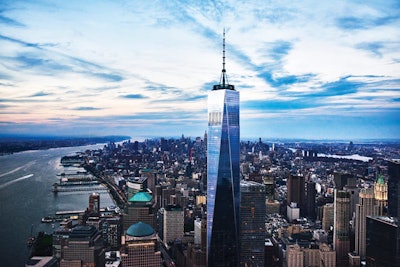
From atop One World Trade Center—the city's tallest building—the One World Observatory will offer panoramic views of New York from levels 100, 101, and 102. The observatory, set to open May 29, is seeking LEED certification for its interior. The entire observatory comprises 120,000 square feet of space. The 102nd floor will serve as a 9,300-square-foot event space that will hold 300 for receptions. It will offer catering and include features such as a sound system and HD projection capabilities. Group rates for admission also are available for groups of 20 or more people.
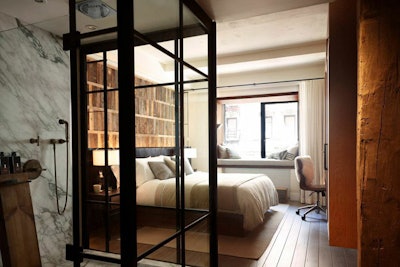
Specifically designed as an eco-friendly hotel brand, 1 Hotel Central Park will make its New York debut this summer. The luxury property, located 58th Street and Sixth Avenue, features interior designs by AvroKo Hospitality that used low-impact, reclaimed, and natural materials. A signature design element from landscape designer Harrison Green of Damien Harrison is a three-story exterior living green wall. The building features energy-efficient heating and cooling systems, low-flow plumbing fixtures, and low-V.O.C paints, adhesives, sealants, and finishes. The property also offers green transportation perks including Tesla electric car service, complimentary bicycle valet, and complimentary parking for guests who bring their own electric vehicles. The property will be home to Jams, chef Jonathan Waxman’s 116-seat restaurant and bar, and have private dining space.
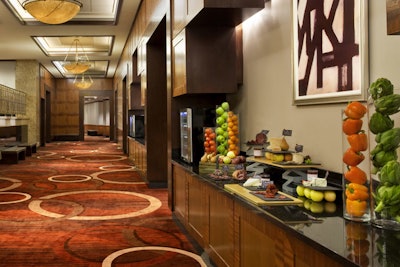
The Sheraton New York Times Square, which debuted a new meeting space in March that caters to smaller groups, has developed green meeting practices such as offering biodegradable or recycled content dinnerware, energy-efficient digital signage, and its “100-mile menu,” which supports farmers within a 100-mile radius who use sustainable farming methods. The hotel also has green design and construction features including a four-pipe HVAC heating and cooling system, energy-efficient lighting, and motion-detection thermostats. The new meeting space, formerly the Executive Conference Center, covers 11,000 square feet on the lower level of the hotel and will be renamed later this spring after a national naming contest for meeting planners. The $2.2 million project refreshed the space’s soft goods, entry lounge, and 13 meeting rooms. Other features include electronic reader boards and a custom boardroom table that is wired for audiovisual hookups. The space is intended for meetings of as many as 150 attendees.
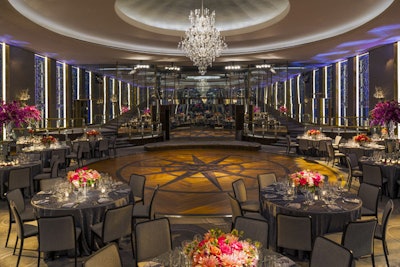
The Rainbow Room, famed for its stunning skyline views from the 65th floor of Rockefeller Center, earned LEED Silver certification in January. The venue, built in 1934, reopened in 2014 after a five-year hiatus. The restored space incorporates sustainability measures such as new Energy Star equipment; low-flow aerators and occupancy water sensors that reduced water consumption by 20 percent; energy-efficient lighting; and a recycling program for paper, cardboard, glass, plastics, and metals. The venue has three spaces for events that can be booked together or separately. The circular Rainbow Room, when combined with the Gallery space, seats 300 guests or holds 250 for dinner with dancing. The chic cocktail lounge SixtyFive seats 92 and attaches to a newly opened terrace.
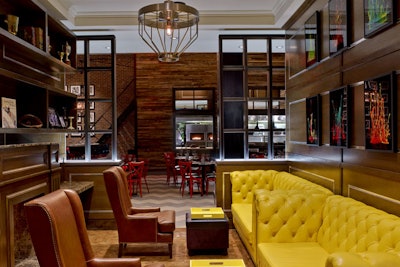
Archer New York, a 180-room hotel in the garment district, is working toward LEED Silver certification. Designed by Glen & Company Architecture, the property worked sustainable initiatives into the design and construction phases as well as its ongoing operations. Examples include energy-efficient heating and cooling systems, a heat and power plant that reduces demand on the electric grid, and an on-site energy recovery unit with an enthalpy wheel used in air ventilation. The hotel also recycled 85 percent of nonhazardous construction waste and debris and used repurposed materials such as wood sourced from a 1770s-era barn in the construction of the on-site restaurant, chef David Burke’s Fabrick. The hotel also offers tours of its facilities and sustainable practices.
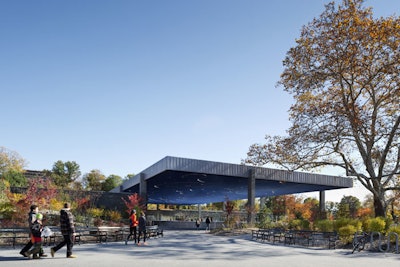
Located in Brooklyn’s Prospect Park, the LeFrak Center at Lakeside serves as an ice skating rink in the winter and a roller skating rink in warmer months. The building, designed by architects Tod Williams and Billie Tsien, received LEED Gold certification in September 2014. Among its green building practices are efficient plumbing fixtures that are estimated to save more than 205,000 gallons of water each year, an energy-saving green roof, a cistern that collects rainwater from the roof and irrigates plantings on the green roof, and a storm water runoff system. The center has three private rink-side party rooms that each hold about 40 guests and can be combined; the entire rink is available for buyout.
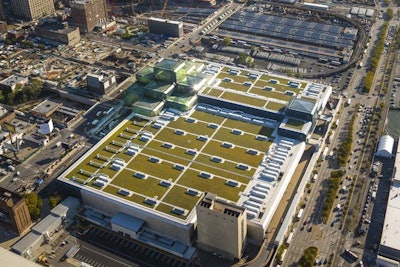
As part of a comprehensive renovation of the Jacob K. Javits Convention Center that finished in 2014, the center added a 6.75-acre green roof designed to reduce storm water runoff (it can collect as much as 6.8 million gallons of water a year). Another benefit to the roof is its role as a habitat for birds: a 2015 ecological study found that 11 bird species use the roof as a habitat. The renovation included other sustainable initiatives such as new energy-efficient mechanical units and lighting that contribute to a 26 percent reduction in the building’s energy consumption. Overall, the convention center has 840,000 square feet of exhibition space, 102 meeting rooms, and four banquet halls.

The Wyndham New Yorker is in the midst of the second phase of a restoration process that has already renovated the Grand Ballroom, other meeting space, and the lobby as well as refreshed many of its 1,024 guest rooms. The Midtown property has a number of eco-friendly practices in place. It purchases energy that was produced by green power—such as solar, hydro, or wind—or buys carbon credits to offset fossil fuel consumption and operates most of its larger air-conditioning motors with variable frequency drives, which allows them to run only as fast as required rather than at full speed. Other initiatives include energy-efficient lighting, low-flow water fixtures, and a solid waste diversion partnership with Great Forest that allowed it to divert 343 tons, or 82 percent of its solid waste stream, away from landfills in 2013. It also donates used soaps, shampoos, and other toiletries to Clean the World, which sterilizes them and distributes them to people in need.

The South of France-inspired bakery Maman, which opened in SoHo in October, has woven a number of eco-friendly practices into its operations. Its food packaging comes from Green Packaging, which specializes in compostable food packaging. Its to-go boxes are made from a variety of surplus agricultural and wildly grown plant fibers such as bulrush, bagasse, bamboo, and wheatstalk. The plants are grown for food and other purposes, with the byproduct used in the tree- and bleach-free packaging. For private events, the space seats 24 or holds 30 for receptions.



















